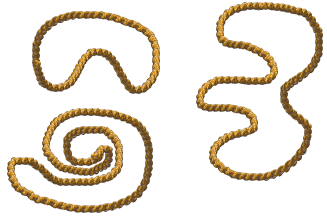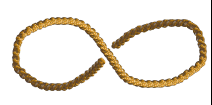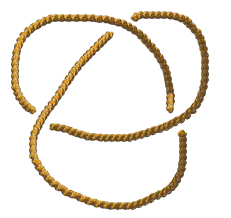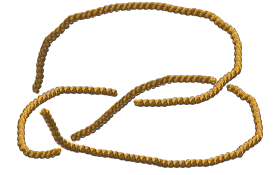Homeomorphism
The technical definition of homeomorphism between two objects requires that it be possible to deform one of the objects in a continuous way so as to produce the other object. The deformation is also required to be a one-to-one correspondence, and it is required that the reversal of the deformation process be continous also. Thus, while a piece of string could be joined at the two ends to form a circle, this would not satisfy the definition of a homeomorphism, because the process would not be one-to-one: the two endpoints would be merged to a single point. (In fact, it can be shown that the string (an interval) is indeed not homeomorphic to the circle.)
As a very elementary example, consider the question of whether the interval
[0,1] is homeomorphic to the interval [0,2]. Intuitively, we would
expect these intervals to be homeomorphic, because [0,1] can be deformed
(by stretching) into the interval [0,2] -- and this stretching appears
to be a one-to-one correspondence, and appears to be continuously reversible
as well. On a more formal level, the function ![]() defined by
defined by ![]() is a one-to-one correspondence between [0,1] and [0,2] which is a continuous
function. Moreover, its reversal, the inverse function
is a one-to-one correspondence between [0,1] and [0,2] which is a continuous
function. Moreover, its reversal, the inverse function ![]() ,
is also a continuous function. Thus, [0,1] is homeomorphic to [0,2].
,
is also a continuous function. Thus, [0,1] is homeomorphic to [0,2].
Not Knots
We now consider objects that are homeomorphic to the unit circle. Such an object is called a simple closed curve. Examples of simple closed curves can be constructed by laying a rubber band on your desk, and stretching and moving it, always keeping it flat on the desk:

We can also construct simple closed curves by utilizing the third dimension -- lifting part of the rubber band out of the plane of the desk -- as long as any apparent "crossover" points really are not intersections of the curve with itself. In a 2-dimensional drawing, we usually show such an overlap by drawing a small gap in the lower portion of the curve:

Knots
Here are some examples of curves that are knotted -- that is,
it is impossible to move the rope around through 3-space to produce an
ordinary circle.
 |
 |
|
|
|
Perhaps you have recognized the graphic on the Vignettes Home Page as a movie of a trefoil knot in the process of being drawn. Knots can be constructed with enormous amounts of complexity, which leads to the mathematical problem of classifying them.
Knot Theory
The main problem of knot theory is the classification of knots -- that is, the determintation of knot types and how to tell when two knots are equivalent. Most of the classification work has revolved around the number of crossings in a knot. For instance, the trefoil knot has three corssings, whereas the figure-eight knot has four. Some things that are known about knots include the following.
Are They Good for Anything?
Surprisingly, chemists and molecular biologists have begun to look toward knot theory to provide insight into the nature and structure of various compounds such as DNA, which exhibits not only twisting, but also knotting. Using the flexible viewpoint of topology rather than the rigid viewpoint of geometry to envision chemical structures may lead to a whole new set of molecules with applications not yet even imagined!
Further Exploration